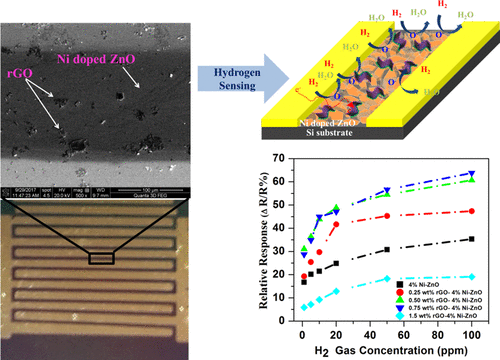当前位置:
X-MOL 学术
›
ACS Appl. Mater. Interfaces
›
论文详情
Our official English website, www.x-mol.net, welcomes your feedback! (Note: you will need to create a separate account there.)
Improved Sensitivity with Low Limit of Detection of a Hydrogen Gas Sensor Based on rGO-Loaded Ni-Doped ZnO Nanostructures
ACS Applied Materials & Interfaces ( IF 9.5 ) Pub Date : 2018-03-14 00:00:00 , DOI: 10.1021/acsami.7b17877 Vijendra Singh Bhati , Sapana Ranwa 1 , Saravanan Rajamani , Kusum Kumari 2 , Ramesh Raliya 3 , Pratim Biswas 3 , Mahesh Kumar
ACS Applied Materials & Interfaces ( IF 9.5 ) Pub Date : 2018-03-14 00:00:00 , DOI: 10.1021/acsami.7b17877 Vijendra Singh Bhati , Sapana Ranwa 1 , Saravanan Rajamani , Kusum Kumari 2 , Ramesh Raliya 3 , Pratim Biswas 3 , Mahesh Kumar
Affiliation

|
We report enhanced hydrogen-gas-sensing performance of a Ni-doped ZnO sensor decorated with the optimum concentration of reduced graphene oxide (rGO). Ni-doped ZnO nanoplates were grown by radio frequency sputtering, rGO was synthesized by Hummer’s method and decorated by the drop cast method of various concentration of rGO (0–1.5 wt %). The current–voltage characteristics of the rGO-loaded sensor are highly influenced by the loading concentration of rGO, where current conduction decreases and sensor resistance increases as the rGO concentration is increased up to 0.75 wt % because of the formation of various Schottky heterojunctions at rGO/ZnO interfaces. With the combined effect of more active site availability and formation of various p–n heterojunctions due to the optimum loading concentration of rGO (0.75 wt %), the sensor shows the maximum sensing response of ∼63.8% for 100 ppm hydrogen at moderate operating temperature (150 °C). The rGO-loaded sensors were able to detect a minimum of 1 ppm hydrogen concentration and showed high selectivity. However, a further increase in the rGO concentration (1.5 wt %) leads to the reduction of the relative response of hydrogen gas, ascribed to the formation of interconnections of rGO between electrodes. Therefore, it reduces the total resistance of the sensor and minimizes the effect of p–n heterojunction on sensor response.
中文翻译:

基于rGO负载的镍掺杂ZnO纳米结构的氢气传感器低灵敏度下的改进的灵敏度
我们报道了用最佳浓度的还原氧化石墨烯(rGO)装饰的掺Ni的ZnO传感器增强的氢气感测性能。通过射频溅射生长掺镍的ZnO纳米板,通过Hummer方法合成rGO,并通过不同浓度rGO(0–1.5 wt%)的滴铸法进行装饰。负载rGO的传感器的电流-电压特性受rGO的负载浓度的很大影响,其中由于rGO上各种肖特基异质结的形成,当rGO浓度增加到0.75 wt%时,电流传导减少,传感器电阻增加/ ZnO接口。由于最佳的rGO负载浓度(0.75 wt%),结合了更多有效位点可用性和各种p–n异质结的形成,在中等工作温度(150°C)下,对于100 ppm的氢气,传感器显示的最大感应响应为〜63.8%。装有rGO的传感器能够检测到至少1 ppm的氢浓度,并显示出高选择性。然而,rGO浓度(1.5wt%)的进一步增加导致氢气的相对响应的降低,这归因于电极之间rGO的互连的形成。因此,它减小了传感器的总电阻,并使PN异质结对传感器响应的影响最小。5wt%)导致氢气的相对响应降低,这归因于电极之间rGO的互连的形成。因此,它减小了传感器的总电阻,并使PN异质结对传感器响应的影响最小。5wt%)导致氢气的相对响应降低,这归因于电极之间rGO的互连的形成。因此,它减小了传感器的总电阻,并使PN异质结对传感器响应的影响最小。
更新日期:2018-03-14
中文翻译:

基于rGO负载的镍掺杂ZnO纳米结构的氢气传感器低灵敏度下的改进的灵敏度
我们报道了用最佳浓度的还原氧化石墨烯(rGO)装饰的掺Ni的ZnO传感器增强的氢气感测性能。通过射频溅射生长掺镍的ZnO纳米板,通过Hummer方法合成rGO,并通过不同浓度rGO(0–1.5 wt%)的滴铸法进行装饰。负载rGO的传感器的电流-电压特性受rGO的负载浓度的很大影响,其中由于rGO上各种肖特基异质结的形成,当rGO浓度增加到0.75 wt%时,电流传导减少,传感器电阻增加/ ZnO接口。由于最佳的rGO负载浓度(0.75 wt%),结合了更多有效位点可用性和各种p–n异质结的形成,在中等工作温度(150°C)下,对于100 ppm的氢气,传感器显示的最大感应响应为〜63.8%。装有rGO的传感器能够检测到至少1 ppm的氢浓度,并显示出高选择性。然而,rGO浓度(1.5wt%)的进一步增加导致氢气的相对响应的降低,这归因于电极之间rGO的互连的形成。因此,它减小了传感器的总电阻,并使PN异质结对传感器响应的影响最小。5wt%)导致氢气的相对响应降低,这归因于电极之间rGO的互连的形成。因此,它减小了传感器的总电阻,并使PN异质结对传感器响应的影响最小。5wt%)导致氢气的相对响应降低,这归因于电极之间rGO的互连的形成。因此,它减小了传感器的总电阻,并使PN异质结对传感器响应的影响最小。



























 京公网安备 11010802027423号
京公网安备 11010802027423号